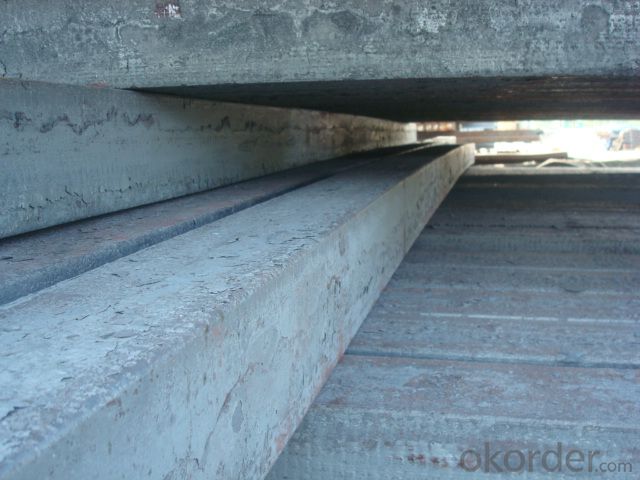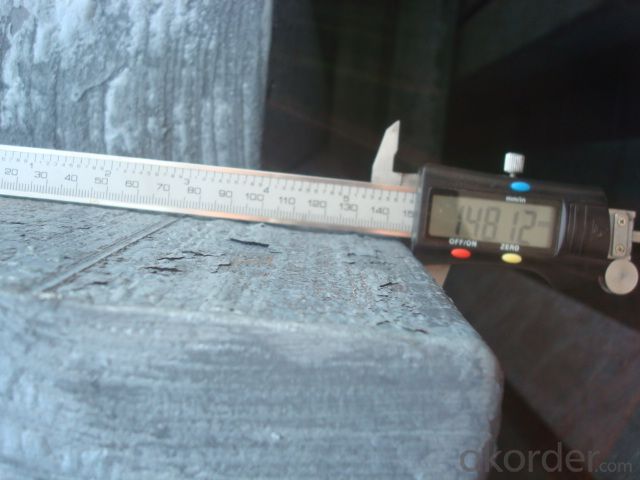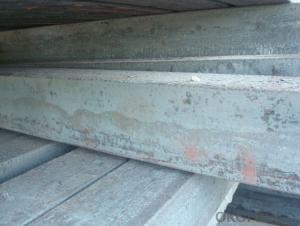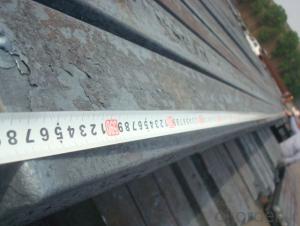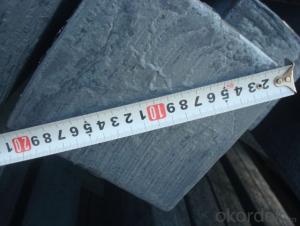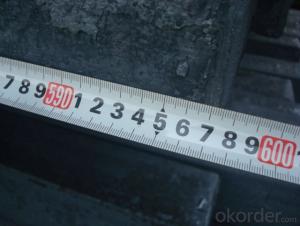Continue Casting Steel Bloom by Blast Furnace
- Loading Port:
- Tianjin
- Payment Terms:
- TT OR LC
- Min Order Qty:
- 2000 m.t.
- Supply Capability:
- 100000 m.t./month
OKorder Service Pledge
OKorder Financial Service
You Might Also Like
Continue Casting Steel Bloom by Blast Furnace
1.Structure of Continue Casting Steel Bloom by Blast Furnace
Continue Casting Steel Bloom by Blast Furnace is the raw material of all kinds of steel mill. Billet section of square, round, flat, rectangular and abnormity, etc Several, mainly related to shape of rolled products. Simple rolled section steel, choose cross section of square billet or rectangular billet. rolling The sector products such as flat steel, Angle steel, select the rectangular billet or slab. Had better profiled billet when production beams, channels, and in rolling process Lines and improve the yield. The raw material of round billet is the production of seamless tube.
2.Main Features of Continue Casting Steel Bloom by Blast Furnace.
Continue Casting Steel Bloom by Blast Furnace section size should meet the requirements of rolling deformation and finished product quality, but also roll strength and biting condition of restrictions. General steel Billet section height H. And the roll diameter D The ratio of the ( namely H/D) Should be less than or equal to zero 0.5 . Length of steel billet by finishing temperature, Rolling time and the length of the product Or times ruler. When heated too long accident prone to bump the furnace wall of steel, too short, furnace bottom utilization rate is not high, influence the heating furnace production. For the production Choose a variety of steel and steel billet, should consider the affinities of billet, as far as possible in order to improve the productivity of the roughing mill, simplify the stock management of workshop.
3. Continue Casting Steel Bloom by Blast Furnace Images
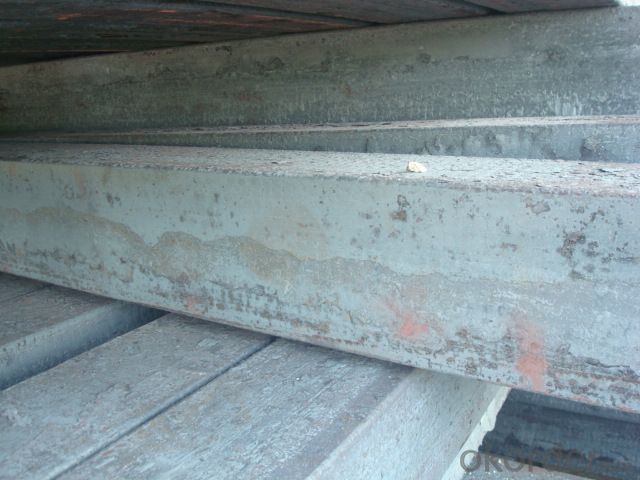
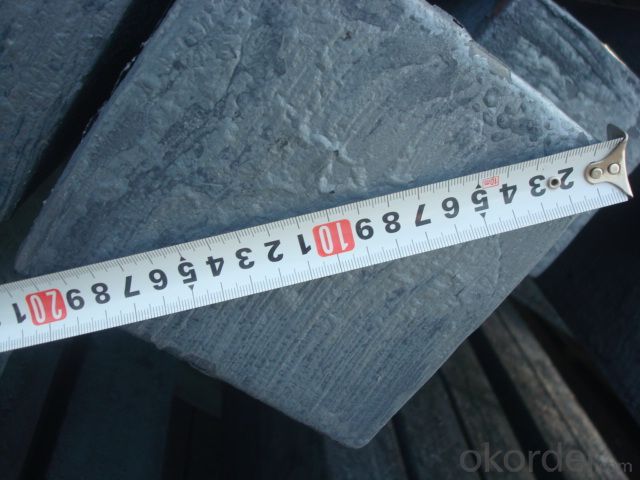
4. Continue Casting Steel Bloom by Blast Furnace Specification
Continue Casting Steel Bloom by Blast Furnace rolled steel, after processing can be used for mechanical parts, forging parts, processing all kinds of steel, steel Q345B channel steel, wire rod is the role of the billet. Steel billet is used in the production of semi-finished products, generally cannot be used directly for the society. Steel billets and steel are strictly divided into standard, cannot decide to whether the business enterprise of the final product, and according to unified standards to perform the whole society. Typically, billet and the steel is relatively easy to distinguish, but for some steel billet, and have the same specification and same steel purposes (such as rolling tube billet), whether can be used for other industries, whether through steel processing process, whether through a finished product rolling mill processing to distinguish
Material standard The editor Range of thickness: 150-240 - mm + / - 5 mm width range: 880-1530 - mm + / - 20 mm Length: 3700-10000 - mm + / - 500 - mm Cross-sectional size: 64 * 64; 82 * 82; 98 * 98; 124 * 124; 120 * 150; 152 * 164; 152 * 170 mm Length: 9000 mm Section of tolerance: billet: 1.0 + / - 2.0-1.0 + / - 1.0 mm slab: width: + / - 2.0 mm thickness: + / - 3.0 mm The length tolerance: + / - 200 mm Section diagonal tolerance: 3.5-8.0 MM Billet section size protrusions requirements: < 1242 mm, do not allow; > = 1242 mm, < = 2 mm 1242 mm, < = 3 mm Beheading (shear) extension deformation: < 1242 mm billet: no control; The slab: < = 15 mm Surface tilt: no more than billet section 0.1 Bending: every 1 m length is not more than 10 mm The distortion: length < = 5 m, < = 11. ; The length of the < = 7.5 M, < = 5. Material % 3 sp/PS chemical composition: C Mn Si S P
5.FAQ of Continue Casting Steel Bloom by Blast Furnace
We have organized several common questions for our clients,may help you sincerely:
①How about your company?
A world class manufacturer & supplier of castings forging in carbon steel and alloy steel,is one of the large-scale professional investment casting production bases in China,consisting of both casting foundry forging and machining factory. Annually more than 8000 tons Precision casting and forging parts are exported to markets in Europe,America and Japan. OEM casting and forging service available according to customer’s requirements.
②How to guarantee the quality of the products?
We have established the international advanced quality management system,every link from raw material to final product we have strict quality test;We resolutely put an end to unqualified products flowing into the market. At the same time, we will provide necessary follow-up service assurance.
③What sizes we can choose?
The normal size: 150*150, 165*165,228*165
- Q: Can steel billets be used for making sculptures?
- Yes, steel billets can be used for making sculptures. Steel is a versatile material that offers strength, durability, and the ability to be shaped and molded into various forms. Many artists have embraced steel as a medium for creating sculptures due to its modern aesthetic and its ability to withstand outdoor conditions. By heating, cutting, and welding the steel billets, artists can transform them into unique and imaginative sculptures.
- Q: What are the potential applications of steel billets in the medical aftermarket?
- Steel billets have potential applications in the medical aftermarket for the manufacturing of surgical instruments, orthopedic implants, and medical equipment components. The high strength, durability, and corrosion resistance of steel make it suitable for these applications, ensuring reliable and long-lasting medical devices. Additionally, steel billets can be customized and shaped to meet specific requirements, allowing for the production of complex and intricate medical instruments and implants.
- Q: How are steel billets used in the manufacturing of wire rods?
- Steel billets are an integral part of the manufacturing process for wire rods. These billets, which are essentially semi-finished steel products, serve as the raw material for producing wire rods. The first step in the manufacturing process involves heating the steel billets to a high temperature in a furnace. This process, known as heating or re-heating, helps to soften the steel and make it more malleable. Once the billets are heated, they are then passed through a series of rolling mills. In these mills, the billets are subjected to intense pressure and are gradually shaped into wire rod form. The rolling process elongates the steel billets and reduces their diameter to the desired size. After the initial rolling, the wire rods undergo further processing to enhance their strength, surface finish, and dimensional accuracy. This may involve various techniques such as cooling, heat treatment, and surface conditioning. Finally, the wire rods are cut into specific lengths and undergo quality control checks to ensure that they meet the required standards. They are then ready to be used in various applications such as construction, automotive, and electrical industries. In summary, steel billets play a crucial role in the manufacturing of wire rods. They are heated, rolled, and processed to create wire rods of different sizes and properties. These wire rods are then used in a wide range of industries, making them an essential component in the manufacturing sector.
- Q: How do steel billets contribute to the manufacturing of rail and transportation systems?
- Steel billets are an essential component in the manufacturing of rail and transportation systems. These billets serve as the raw material for the production of various components used in the construction of railways, such as rails, sleepers, and fasteners. One of the primary uses of steel billets in rail manufacturing is for the production of railway tracks. Steel billets are first heated and then rolled into long, slender sections called rails. These rails are then further processed and treated to withstand the heavy loads and constant wear and tear experienced in railway operations. The durability, strength, and resistance to deformation of steel make it an ideal material for railway tracks, ensuring safe and efficient transportation. Steel billets also play a vital role in the manufacturing of sleepers or railroad ties, which are used to support the rails and maintain their alignment. These sleepers, typically made from prestressed concrete or wood, require reinforcing bars made from steel billets to enhance their strength and structural integrity. Additionally, steel billets are used to produce fasteners, such as bolts, clips, and spikes, which are crucial for securely fastening rails to sleepers and maintaining track stability. Moreover, steel billets are used in the production of various transportation system components, including chassis, frames, and suspension systems for trains, trams, buses, and other vehicles. Their high strength and excellent formability make steel billets an ideal choice for these applications, as they can withstand the heavy loads and provide structural integrity necessary for safe and reliable transportation. In summary, steel billets play a significant role in the manufacturing of rail and transportation systems. From the production of railway tracks to the fabrication of sleepers, fasteners, and vehicle components, steel billets provide the necessary strength, durability, and structural integrity required for the efficient and safe operation of railways and transportation systems.
- Q: Can steel billets be welded together?
- Yes, steel billets can be welded together. Welding is a common method used to join steel billets by heating the surfaces to a molten state and then allowing them to cool and solidify, resulting in a strong and continuous joint.
- Q: What is the role of steel billets in the construction of underground tunnels?
- Steel billets play a crucial role in the construction of underground tunnels. These cylindrical steel bars are used as the primary raw material for manufacturing various structural components, such as reinforcements and supports, that are essential in ensuring the stability and safety of the tunnel. One of the main applications of steel billets is in the creation of rebar, which is short for reinforcing bar. Rebars are embedded within the concrete walls and floors of the tunnel, providing tensile strength and preventing cracking or collapsing under the immense pressure exerted by the surrounding soil or water. These steel bars reinforce the concrete, making it more durable and resistant to deformation, thus enhancing the overall structural integrity of the tunnel. Additionally, steel billets are also used to produce other essential tunnel components, such as tunnel segments and steel arches. Tunnel segments are precast concrete elements that form the lining of the tunnel, and they often incorporate steel reinforcement to enhance their strength. Steel arches, on the other hand, are used in the construction of tunnel roofs to provide additional support and stability. Furthermore, steel billets are employed in the fabrication of various tunnel reinforcement systems, such as rock bolts and ground anchors. These systems help secure loose or unstable rock formations, preventing them from collapsing and endangering the tunnel's stability. Steel billets are also utilized in the manufacturing of tunnel supports, such as steel ribs and beams, which provide additional strength and rigidity to the tunnel structure. In summary, steel billets serve as a critical raw material for the construction of underground tunnels. Through their transformation into rebar, tunnel segments, steel arches, and reinforcement systems, they play a vital role in ensuring the structural integrity, stability, and safety of tunnels, thereby facilitating efficient and secure transportation networks underground.
- Q: What are the main challenges in sourcing steel billets?
- There are several main challenges in sourcing steel billets. Firstly, one of the key challenges is ensuring a consistent and reliable supply of high-quality steel billets. Steel billets are typically sourced from steel mills or manufacturers, and it is crucial to find suppliers that can consistently meet the required specifications and standards. This involves conducting thorough research and due diligence to identify reputable and reliable suppliers who have a track record of producing high-quality billets. Another challenge is managing the cost and price fluctuations of steel billets. Steel prices are subject to various factors such as global demand, raw material costs, and market dynamics. As a result, the price of steel billets can be volatile, which can impact procurement decisions and budgets. Sourcing professionals need to carefully monitor market trends and negotiate pricing contracts to ensure the best value for their organization. Furthermore, logistics and transportation can pose challenges in sourcing steel billets. Steel billets are heavy and bulky, making transportation and logistics complex. Coordinating deliveries, managing shipping schedules, and ensuring timely arrival of the billets can be challenging, especially when sourcing from international suppliers. It is important to work closely with reliable logistics partners and have a robust supply chain management system in place to overcome these challenges. Quality control is another crucial aspect in sourcing steel billets. Due to the critical nature of steel in various industries, it is essential to ensure that the billets meet the required quality standards. This involves conducting quality inspections, reviewing certifications, and performing material testing to verify the integrity and properties of the billets. Regular audits and inspections should be conducted to maintain consistent quality throughout the sourcing process. Lastly, regulatory compliance and trade restrictions can present challenges in sourcing steel billets. Import/export regulations, tariffs, and trade barriers can impact the availability and cost of steel billets from certain regions. Sourcing professionals need to stay updated with the latest regulations and trade policies to navigate these challenges and ensure compliance with the applicable laws. In conclusion, the main challenges in sourcing steel billets include ensuring a consistent supply of high-quality billets, managing price fluctuations, handling logistics and transportation, maintaining quality control, and complying with regulatory requirements. Overcoming these challenges requires careful supplier selection, effective negotiation, robust supply chain management, and staying informed about market trends and regulations.
- Q: What are the main factors affecting the formability of stainless steel billets?
- The main factors affecting the formability of stainless steel billets include the composition of the steel, its microstructure, temperature, strain rate, and lubrication during the forming process. Additionally, the presence of impurities, such as sulfur and phosphorus, can also impact formability.
- Q: How do steel billets contribute to the overall sustainability of a product?
- Steel billets contribute to the overall sustainability of a product by enabling efficient use of resources and minimizing waste. They are produced from recycled steel, reducing the need for extracting raw materials and conserving energy. By providing a high-quality starting material for various steel products, billets promote durability and longevity, reducing the need for frequent replacements. Additionally, their uniform shape and size facilitate efficient manufacturing processes, resulting in reduced energy consumption and emissions.
- Q: What are the advantages of using steel billets in manufacturing?
- There are several advantages of using steel billets in manufacturing processes. Firstly, steel billets offer exceptional strength and durability. Steel is known for its high tensile strength, making it ideal for applications that require heavy loads or resistance to wear and tear. This strength ensures that products made from steel billets are long-lasting and can withstand harsh conditions, increasing their lifespan and reducing the need for frequent replacements. Secondly, steel billets are highly versatile. They can be easily molded and shaped into various forms, allowing manufacturers to create a wide range of products with different designs and specifications. This versatility makes steel billets suitable for a diverse range of industries, including construction, automotive, machinery, and appliances. Furthermore, steel billets are cost-effective. Steel is one of the most affordable and readily available materials in the manufacturing industry. Its widespread availability ensures a steady supply, reducing the cost of production. Additionally, steel's durability minimizes maintenance and replacement expenses, saving money in the long run. Another advantage of using steel billets is their eco-friendliness. Steel is a highly recyclable material, and using steel billets in manufacturing promotes sustainability. Recycling steel reduces the need for mining raw materials, conserves energy, and decreases carbon emissions. Therefore, steel billets contribute to a greener manufacturing process and support environmental conservation efforts. Lastly, steel billets offer excellent performance characteristics. Steel has exceptional thermal and electrical conductivity properties, making it suitable for applications that require heat dissipation or electrical conduction. Additionally, steel is resistant to corrosion, rust, and fire, adding an extra layer of protection to products manufactured using steel billets. In conclusion, the advantages of using steel billets in manufacturing are its strength and durability, versatility, cost-effectiveness, eco-friendliness, and exceptional performance characteristics. These advantages make steel billets a preferred choice for various industries, ensuring high-quality products that withstand the test of time.
Send your message to us
Continue Casting Steel Bloom by Blast Furnace
- Loading Port:
- Tianjin
- Payment Terms:
- TT OR LC
- Min Order Qty:
- 2000 m.t.
- Supply Capability:
- 100000 m.t./month
OKorder Service Pledge
OKorder Financial Service
Similar products
Hot products
Hot Searches
Related keywords


